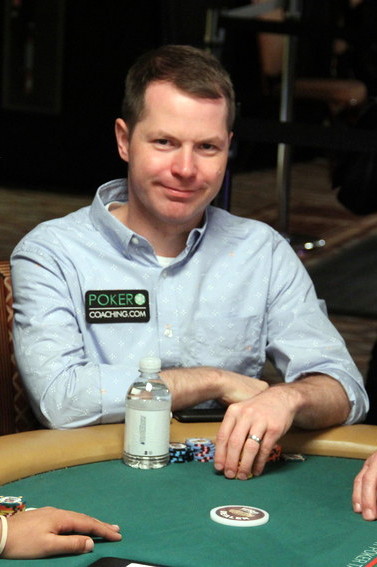Card Player Magazine, available in print and online, covers poker strategy, poker news, online and casino poker, and poker legislation. Sign up today for a digital subscription to access more than 800 magazine issues and get 26 new issues per year!
 We are playing in a $25,000 buy-in high roller event. We have 3
We are playing in a $25,000 buy-in high roller event. We have 3 3
3 in the hijack with 116,000 chips and blinds are 150-300 with a 25 ante.
in the hijack with 116,000 chips and blinds are 150-300 with a 25 ante.
Here are the stack sizes of the players at the table:
Middle Position – 140K (a.k.a. Villain 1)
Hijack – 116K (You)
Button – 160K (Villain 2)
Small Blind – 97K
Big Blind – 108K
Villain 1 in this hand is an experienced older live pro better known for stud than hold’em. Villain 2 is an older player who has had great success. He plays generally tight and straightforward, but is certainly capable of getting out of line when the time is right.
Villain 1 raised to 800.
QUESTION 1: The action is on you in the hijack; what do you do with 3 3
3 ?
?
A. Fold
B. Call 800
C. Three-bet to 2,300
D. Three-bet to 3,900
While you should usually call preflop with pairs, from time to time you should three-bet to disguise your range. Against a player who is generally weak at hold’em but familiar with poker, you can get away with three-betting some marginal hands and representing whatever comes on the flop, as stud players tend to be a little tight and easy to push around post-flop.
So, you choose C and three-bet to 2,300. Calling would also be perfectly fine.
Villain 2 four-bets to 6,000 and Villain 1 quickly folds.
QUESTION 2: The pot is 9,775 and the effective stack size is 113,700. What is your action?
A. Fold
B. Call the 3,700
C. Five-bet to 10,000
D. Go all-in
When a tight and straightforward player puts in a four-bet, you should nearly always set mine when this deep stacked. The one big negative about this hand is that you are out of position. This will make it difficult for you to win your opponent’s stack when you happen to flop a set. If you think your opponent is likely to be four-bet bluffing, you can consider putting in a small five-bet, but that’s a little too crazy against a normally tight player.
You choose B and call.
The flop comes J 6
6 3
3 , giving you bottom set.
, giving you bottom set.
QUESTION 3: The pot is 13,475 and the effective stack size is 106,000. What is your action?
A. Check
B. Bet 4,000
C. Bet 7,000
D. Bet 13,000
When you flop a set in a four-bet pot, you need to figure out the best way to get all the money in. When someone cold four-bets, he usually has a strong range such as A-A, K-K, Q-Q, A-K, and a few random bluffs. Because of this, both leading with a large bet and checking are fine options. Against someone who is good and capable of hand reading, the best line is to check with the intention of check-calling down with the hope of raising the river as long as the board doesn’t get too scary.
You choose A and check, and Villain 2 checks behind.
Your opponent is smart enough to check behind on the flop, both for pot control and to make his range look weak, even though you know it is still made up of mostly premium hands.
The turn is the K .
.
QUESTION 4: The pot is 13,475 and the effective stack size is 106,000. What is your action?
A. Check
B. Bet 4,000
C. Bet 7,000
D. Bet 13,000
The king is both a good card and a bad card. Your opponent almost certainly has a strong hand at this point, unless he has Q-Q. This means you should try to get money in the pot. However, since your opponent is a smart player, he may actually bet A-A and A-K if you check to him and fold if raised, fearing a set or a flush, as most players would never or rarely check-raise with a bluff. If he has K-K, you are in terrible shape. This makes check-raising a poor option. You could bet into your opponent, but if he calls and the river is a heart, he may figure out a way to bluff you off your hand, which would be a disaster. As unfortunate as it is, check-calling is probably the best line.
You check and Villain 2 bets 7,000.
QUESTION 5: The pot is 20,475 and the effective stack size is 106,000. What is your action?
A. Fold
B. Call 7,000
C. Raise to 19,000
D. Raise to 36,000
Sticking with the plan, check-calling is the only play that makes sense. If you think your opponent will never fold A-A or A-K in this situation but will always re-raise with K-K, you could raise for value. However, the best way to get value out of your strong opponent is to allow him to continue betting on the river with what he thinks is the obvious best hand or with one of his few bluffs. Calling also makes it difficult for you to go broke when you happen to be beat.
You decide to call. The river is the 7 .
.
QUESTION 6: The pot is 34,475 and the effective stack size is 99,000. What is your action?
A. Check
B. Bet 12,000
C. Bet 24,000
D. Bet 35,000
As you can see, thinking ahead is crucial. At this point, the plan should be to check and call whatever Villain 2 bets. The big difference between leading into your opponent and checking in this spot is if you’re beat, you will have to fold your hand to a raise. While some players are capable of a big river bluff raise, there’s no point in risking it when your opponent will almost certainly bet A-A and A-K for value as well as some random bluffs. If you’re going to lead, you should make it a size where your opponent would be insane to run a bluff, allowing you to easily fold if he shoves.
You check and he quickly bets 18,000.
QUESTION 7: The pot is 52,475 and the effective stack size is 99,000. What is your action?
A. Fold
B. Call 18,000
C. Raise to 43,000
D. Go all-in
Given the way the hand played out, your only good option on the river is to call. You could consider a value raise but Villain 2 would likely fold A-A or A-K. When you’re extraordinarily deep stacked, it’s difficult to get all the money in, even with a set.
In a cash game, you could have taken a different line, check-raising the flop, but in a tournament, the chips you stand to lose, which is your entire stack in this situation, are worth well more than the chips you stand to gain. Don’t fall prey to the avoidable “bad beats” you constantly hear amateur players discussing. Not going broke is important!
You call and beat your opponent’s A-A. ♠
 Jonathan Little is a professional poker player and best-selling poker author with over $6,900,000 in live tournament earnings. If you want to learn how to play fundamentally sound poker and increase your win rate, check out PokerCoaching.com. Click here to try PokerCoaching.com for free.
Jonathan Little is a professional poker player and best-selling poker author with over $6,900,000 in live tournament earnings. If you want to learn how to play fundamentally sound poker and increase your win rate, check out PokerCoaching.com. Click here to try PokerCoaching.com for free.

.jpg)
